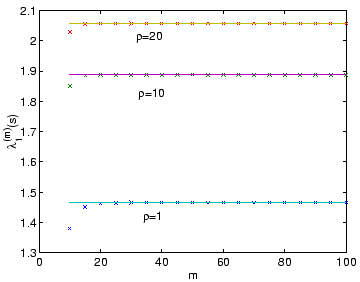In general one may therefore expect speeds of the nonlinear invasion, governed by the infinite system (2), to approach speeds predicted for the linear system, (6), using the minimum-speed methodology from the previous sections. An additional, new, wrinkle occurs because of the age structure: invasions are initialized with lesions of age 1, and the actual dynamic progress of the disease is modelled by application of finite operators, whose number of entries grows by one for each day following the inception of the invasion. Consequently, when considering the observability of the predicted wave speed there are two convergence issues to consider. The first is the traditional issue concerning the rate at which nonlinear fronts of fixed dimensionality approach the minimal wave speed. The second, novel issue concerns the rate at which the finite dimensional eigenvalue, presumably controlling the speed of propagation in the age-structured population, approaches the largest eigenvalue in the infinite system.
Let
![]() be the leading
be the leading ![]() submatrix of
submatrix of ![]() from (17), where
from (17), where ![]() is defined by (18).
Let
is defined by (18).
Let
![]() denote the largest positive eigenvalue of
denote the largest positive eigenvalue of
![]() .
To estimate effect of reduction to finite dimension for the linearized case,
we need to compute
.
To estimate effect of reduction to finite dimension for the linearized case,
we need to compute
![]() , and compare it to
, and compare it to ![]() .
First, since
.
First, since
![]() is non-negative and irreducible,
by the Perron-Frobenius Theorem [14, Theorem 9.2.1]
it follows that the absolutely largest eigenvalue of
is non-negative and irreducible,
by the Perron-Frobenius Theorem [14, Theorem 9.2.1]
it follows that the absolutely largest eigenvalue of
![]() is real and positive.
Thus
is real and positive.
Thus
![]() exists for every
exists for every
![]() and it is equal to the spectral radius of
and it is equal to the spectral radius of
![]() .
For example, Figure 2 shows the eigenvalues of
.
For example, Figure 2 shows the eigenvalues of
![]() for
for ![]() . In Figure 2 we see six distinct eigenvalues (there
are five distinct eigenvalues for odd
. In Figure 2 we see six distinct eigenvalues (there
are five distinct eigenvalues for odd ![]() ), and the rest of the eigenvalues
are close to the outer border of the unit circle.
), and the rest of the eigenvalues
are close to the outer border of the unit circle.
 |
Let us prove that the sequence of largest eigenvalues,
![]() , is convergent for
, is convergent for ![]() fixed.
We do this by proving that the sequence is
bounded and increasing. Let
fixed.
We do this by proving that the sequence is
bounded and increasing. Let
 |
Two questions remain to be answered: